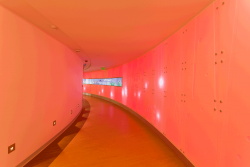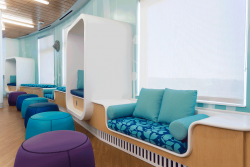
When you think of countertop materials, you probably picture a flat surface. Physics, however, has brought much more creativity to modern times. Thanks to a knowledge in physics, HOT new trends using countertop materials have been invented. One is a process that allows solid surface to be molded into virtually any shape. This process is called thermoforming.
What Is Thermoforming?
Thermoforming is defined as the process of heating and shaping synthetic material. It allows fabricators to utilize solid surface (often Corian®) to create 3-D curves and complex, rounded shapes. Notice that the definition specifically mentions synthetic materials. Although quartz is a synthetic material, it does not have enough flexibility to allow for thermoforming; therefore, this process is limited to solid surface. That means that materials such as quartz, marble, and granite are not proper candidates.
The Process
Thermoforming: the word alone sounds scientific and complex. Just like it sounds, the process is very advanced and requires specific technology. It may be intricate, but we have broken the steps down and summarized them for you to help you gain a better understanding of the process.
- Preparation: To prepare the solid surface material, it must be cut slightly larger than the final dimension because it shrinks after heating. The edges must be sanded smooth with no chips, cracks or scratches. Small chips, cracks and scratches can cause cracks to develop at a later time.
- Heating: To begin thermoforming, the material is heated it to the point that it becomes very flexible. It is best to heat the entire piece of material. If only a small section where the bend will occur is heated, it is easier for stress to develop at the interface of the heated and not heated portions. The temperature that the material is heated depends on the composition of the material. It is imperative to apply the correct temperature for the particular material used. Under heating the material can result in cracking, breaking or stretch marks. Overheating the material may cause it to bubble or blister. Regardless, a side effect of heating solid surface is a darkening of color.
- Bending and Shaping: After the material has reached the intended temperature, remove it from the oven and carefully shape it into the desired form. Bending it too quickly can cause it to crack, break, or form white stretch marks. If bent too slowly, however, it may cool too soon.
- Forms and Molds: Create a set of molds from plywood or MDF for the material to be placed between while it cools. The material should be cooled below 170° before taking it out of the mold.
Examples From Cameo Countertops, Inc.
Cameo Countertops, Inc. loves creative opportunities involving innovative processes, such as thermoforming. Customers can design their own unique touches by bending and shaping solid surfaces. Thermoforming is how we were able to bring the creative designs used at the Angie Fowler Adolescent & Young Adult Cancer Institute to life! The institute features a wide variety of Corian® designs, unique to that project. One aspect features a back lit, color changing, Corian® wall. We were even able to create an outdoor space full of fun shapes and designs. With thermoforming, the creativity is limitless!




We hope that you enjoyed this HOT lesson in physics. Hopefully it SPARKS some creativity now that you know all about thermoforming. Thermoforming is a complex process. Luckily, Cameo Countertops, Inc. has cutting edge material, paired with trained experts who have the ability to provide you with this option.
